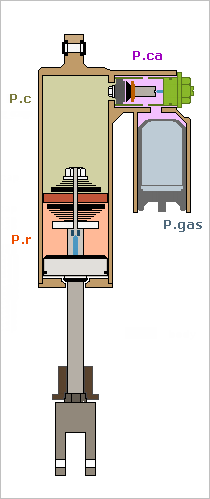| A BRIEF HISTORY AND DISCLAIMERS |
|
- FIRST DISCLAIMER
- I don't know what I'm talking about.
|
|
Convert N to kg
- Both the fork and shock can be dyno tested.
- -
- There are two different types of dyno tests. We refer to them as:
- Dyno load cell test:
- where the load cell records the overall compression and rebound forces from the shock.
- Pressure test:
- Pressure sensors are added to the shock body recording pressures in the three chambers.
- P.c . . . pressure in the compression chamber (comp).
- P.r . . . pressure in the rebound chamber (reb).
- P.ca . . pressure in the compression adjuster chamber (cadj).
- P.gas . pressure in the reservoir, which is the same as P.ca, so we don't record P.gas.
|
|
 |
Convert N to kg
- In 2006 we acquired a dyno and started running tests.
- The test results were not what we expected, so we decided to document these discoveries.
- -
- From 2006 - 2013 we ran the dyno load cell tests.
- Any documentation in that time frame is limited to our experience with load cell results.
- From 2013 - present we run both dyno load cell and pressure tests.
- Documentation from 2013-on is more precise and includes pressure test experience.
- We had found that incorrect assumptions were made with the load cell tests because we didn't have a breakdown of the forces.
- -
- Pressure testing breaks down the forces into their four main parts:
- comp force from the main piston
- cadj force from the cadj piston
- gas force from the nitrogen charge
- drag force from the shaft seal, bushing and piston band
|
|
- SECOND DISCLAIMER
- With hands-on experience we thought we knew what we were talking about, then learned we didn't.
- With dyno experience we thought we knew what we were talking about, and found out we didn't.
- Now with press testing experience we think we know what we're talking about, but probably don't.
- HENCE THE DISCLAIMER
- We don't know what we're talking about.
|
|
